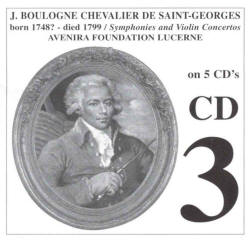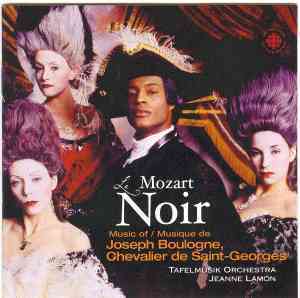Home
Blog
Composers
Musicians
Black History
Audio
About Us
Links
Saint-Georges Biography
Saint-Georges Sub-pages:
Gian Faldoni
Violin Concertos
Symphonies
String Quartets
Harpsichord Sonatas
AfriClassical Blog
Companion to AfriClassical.com
Guest Book
William J. Zick, Webmaster,
wzick@ameritech.net
©
Copyright 2006-2022
William J. Zick
All rights reserved for all content of AfriClassical.com

(10)

(6)

(3)
|
Home ->
Composers -> Saint-Georges, Le
Chevalier de -> Symphonies
Français
Audio
Samples: CDs 2, 3 & 5
(1) CBC SMCD 5225 (2003)
Symphony in G Major, Op. 11, No. 1
Tafelmusik Baroque Orchestra; Jeanne Lamon, Conductor; CBC
Records SMCD 5225 (2003). Le Mozart Noir also
includes the Violin Concerto in D Major, Op. 3, No. 1
as well as the overture and ballet excerpts from the comic opera
L'amant anonyme [The Anonymous Lover].
François-Joseph Gossec (1734-1829) and Jean-Marie Leclair
(1697-1764) are also represented on the disc by examples of
their own compositions. Gossec taught music to
Saint-Georges, and Leclair may also have done so.
(2) Avenira AV 9985 2E (2000)
Symphony in D Major, Op. 11, No. 2 (11:45)
(3) Avenira AV 9987 2E (2000)
Symphony Concertante in A Major, Opus 10, No. 2
(14:47)
Symphony Concertante in E Flat Major, Opus 12 (13:44)
(4) Avenira AV 9988 2E (2000)
Symphony Concertante in F Major, Opus 10, No. 1 (10:59)
(5) Avenira AV 9989 2E (2000)
Symphony Concertante in C Major, Opus 9, No.1
(14:09);
Symphony Concertante in A Major, Opus 9, No. 2 (17:46)
Le Chevalier de Saint-Georges was a pioneer of the form known as
symphony concertante, which pairs two or more soloists with an
orchestra. On all three CDs the soloists are Jiri Zilak,
Violin, and Jan Motlik, Alto. The Radio Symphony Orchestra
of Pilsen is conducted by Frantisek Preisler.
Le Fleuret et l'Archet [Foil & Bow], published by
the Departmental Archives of Guadeloupe in 2001, says
[Translation from French]:
|
With musical life at its height, focusing on
concerts and on flourishing publishing activity,
Paris saw the emergence, around 1770, of a
new musical genre: the symphonie
concertante. Derived from the Italian concerto
grosso, it gave the most attractive part of the
performance of the entire symphony to a
dialogue allowed between two or three
instruments. The symphonie concertante can
be defined as a concerto with several solo
instruments, varying from two to seven. This
galante genre of expression replaced the
rocaille style of the preceding musical epoch.
The galante style is based at once on
virtuosity and on the power of melodicattraction. The choice of instruments is left to
the imagination of the composer (two violins,
two violins and alto, harpsichord and
pianoforte, two clarinets, horn, bassoon, oboe
and clarinet...). Between 1770 and 1830,
more than two hundred symphonies
concertantes were composed and published
in the capital, making Paris one of the premier
musical centers of Europe. |
(6) Arion 55434 (1998)
Symphony in G Major, Op. 11, No. 1
Symphony in D Major, Op. 11, No. 2
Anne-Claude Villars, Principal Violin; Chamber Orchestra of
Versailles; Bernard Wahl, Conductor; Arion 55434 (1998)
(7) Assai 222662 (2004)
Symphony in G Major,
Op. 11, No. 1
Symphony in D Major, Op. 11, No. 2
Stéphanie-Marie Degand, Violin; Le Parlement de Musique; Martin
Gester, Conductor; Assai 222662 (2004)
(8) Calliope 9373 (2007)
Symphony Concertante in G Major for 2 Violins, Op. 1, No. 3
Christophe Guiot and Bertrand Cervera, Violins; Les Archets de
Paris;
Calliope 9373 (2007)
(9) Avenira AV 276017 (2008)
Symphony Concertante in C Major, Op. 6, No. 1
Symphony Concertante in B-flat Major, Op. 6, No. 2
Symphony Concertante in C Major, Op. 9, No. 1
Symphony Concertante in A Major, Op. 9, No. 2
Miroslav Vilímec, Jiří Žilák and Michal Pospíšil, Violins;
Pilsen Philharmonic Orchestra; Jiří Malát and František Preisler,
Conductors; Avenira AV 276017 (2008). Michelle
Garnier-Panafieu writes in the liner notes:
|
With
Giuseppe Maria Cambini and Jean-Baptiste Davaux,
Saint-George was among the composers who excelled in the
genre that was to survive the Revolution and to persist
into the nineteenth century under the title of double
concerto or triple concerto (we are, of
course, thinking of Beethoven).
Saint-George composed eight symphonies concertantes:
two Opus 6, two Opus 9, two Opus 10, one Opus 12 and one
Opus 13. They were published between 1775 and
1782, his most productive years as a composer, when he
was at the forefront of Parisian musical life as
conductor of the Concert des Amateurs, then of the
Concert de la Loge Olympique. So it was after
acquiring ample experience in the composition of violin
concertos - by 1775, when his two Concertos Opus 5 were
published, he had already brought out six - that he
explored the expressive possibilities of this new hybrid
genre, half-way between the symphony and the concerto.
Only the second of his symphonies concertantes
(Op. 6, No. 2) is in three movements; the others are in
two (Allegro with cadential ornamentation, and
Rondeau), following the general rule that was in
force around 1775. They require reasonable
virtuosity of the soloists and their appeal lies above
all in their charm and elegance, with melodic fluidity
and grace always prominent. |
(10) Avenira AV 276018 (2008)
Symphony Concertante in F Major, Op. 10, No. 1
Symphony Concertante in A Major, Op. 10, No. 2
Symphony Concertante in E-flat Major, Op. 12, No. 1
Symphony Concertante in G Major, Op. 13, No. 2
Jiří Žilák, Michal Pospíšil and Jan Motlik, Violins; Pilsen
Philharmonic Orchestra; František Preisler, Conductor; Avenira
AV 276018 (2008)
This page was last updated
on
March 5, 2022
|




